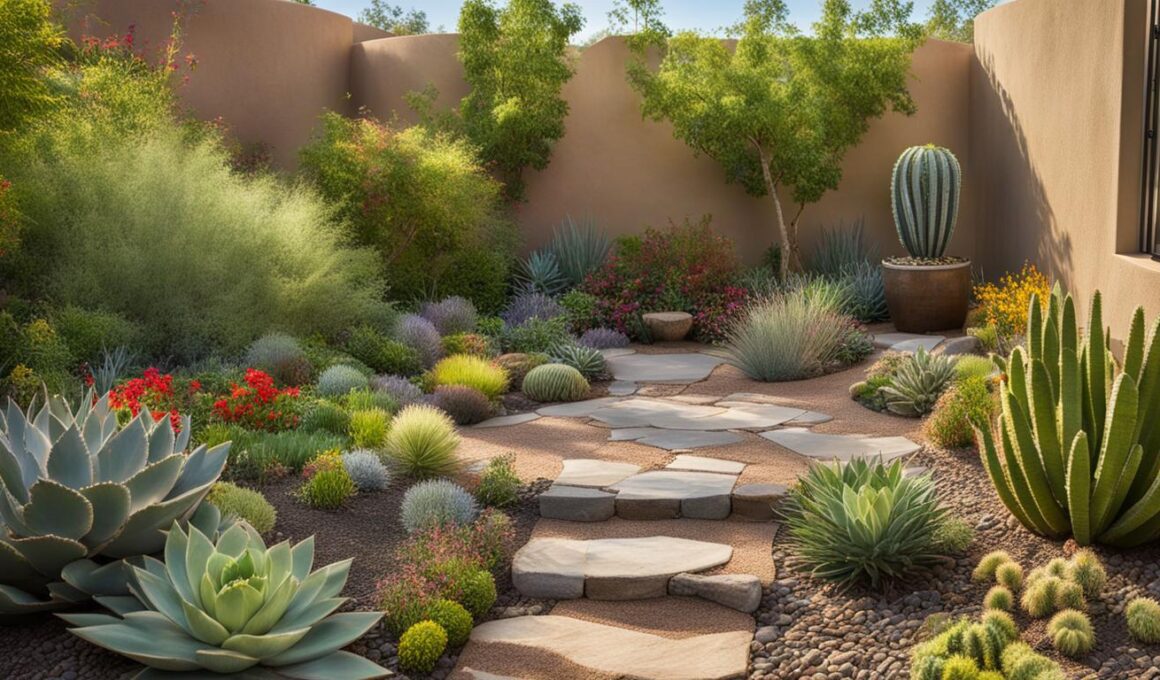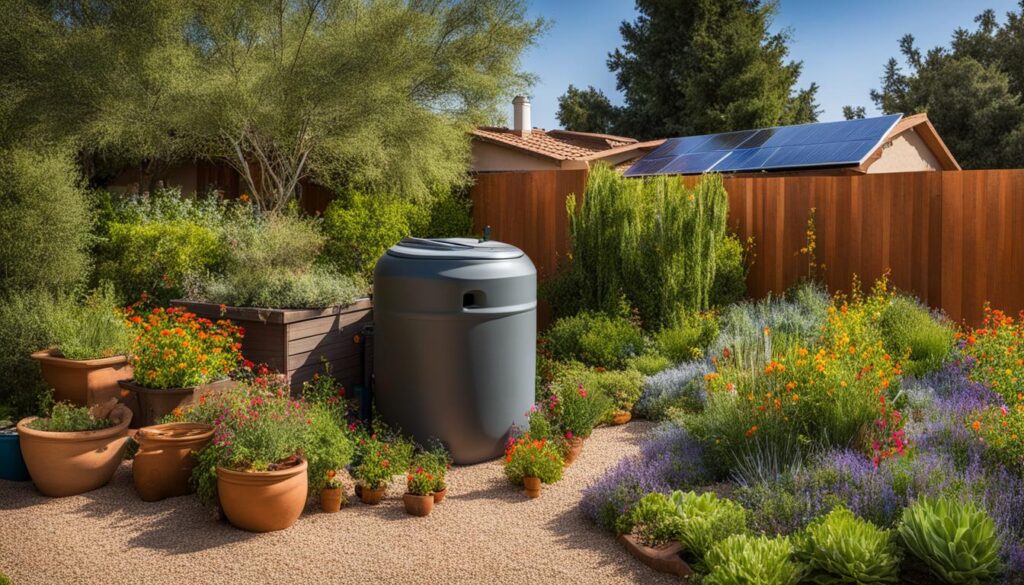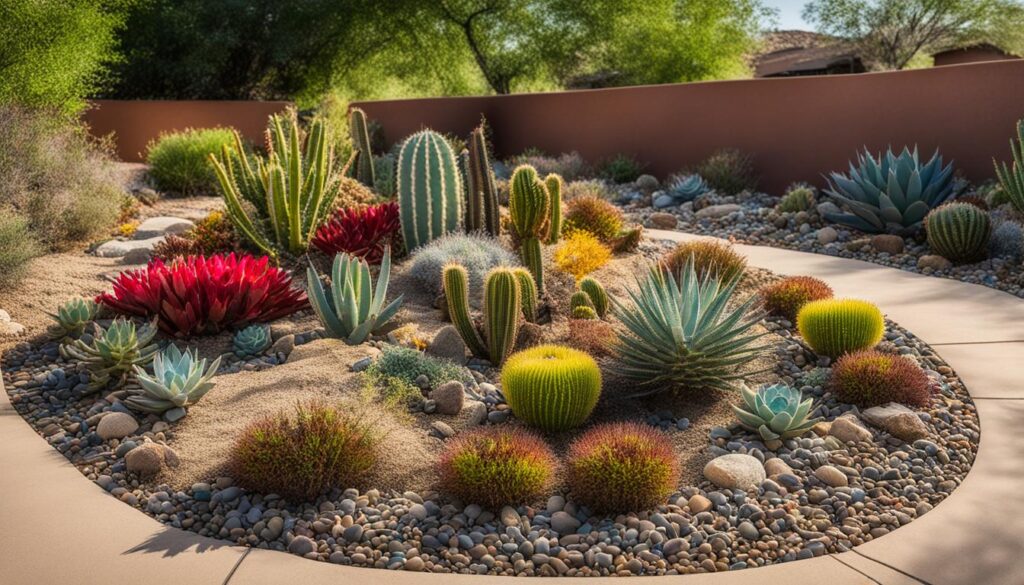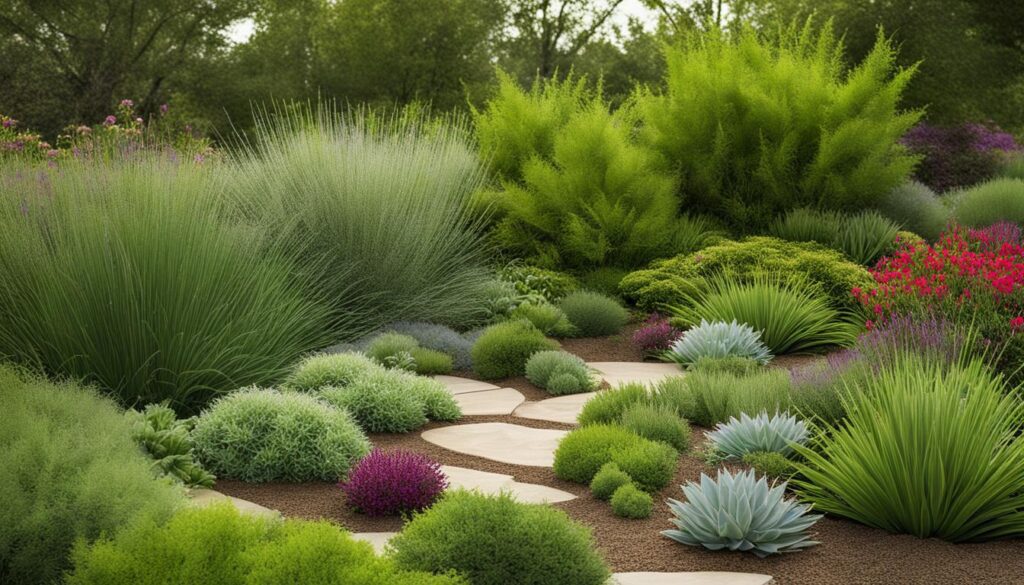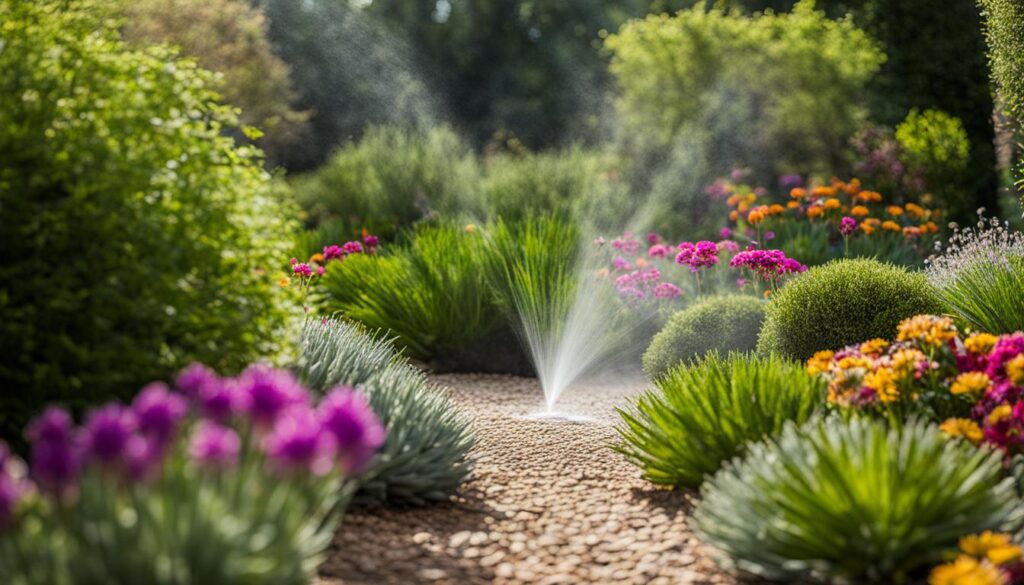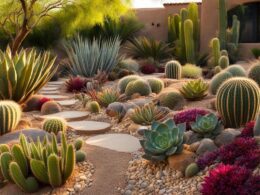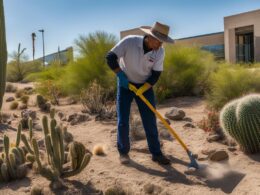Welcome to our guide on sustainable xeriscaping for home gardeners! If you’re looking to create an eco-friendly, water-wise garden that saves resources and still looks great, you’ve come to the right place. Sustainable landscaping and xeriscaping techniques can help you achieve just that. By reducing water consumption, using drought-resistant plants, and implementing water-saving practices, you can enjoy the benefits of a sustainable, beautiful garden while contributing to a greener future.
Key Takeaways:
- Sustainable xeriscaping is an eco-friendly approach to home gardening.
- It focuses on conserving water, using drought-resistant plants, and implementing efficient irrigation systems.
- Xeriscaping offers benefits such as water conservation, cost savings, low maintenance, and beautiful landscapes.
- By incorporating xeriscaping techniques, you can create a garden that is both sustainable and visually appealing.
- K-Rain offers sprinkler systems and products that support water conservation and sustainable landscaping practices.
What is Sustainable Landscaping & Xeriscaping?
Sustainable landscaping focuses on creating outdoor spaces that not only enhance the beauty of your property but also contribute to the well-being of the environment and the community. It involves using practices that conserve resources, preserve native habitats, and support biodiversity. Xeriscaping, on the other hand, is a specific form of sustainable landscaping that emphasizes water-saving techniques.
By incorporating xeriscaping into your garden, you can reduce water consumption, minimize pesticide use, and create a more sustainable and eco-friendly outdoor space. The key principle of xeriscaping is to choose drought-resistant plants that can thrive in your region’s climate. These plants have adapted to survive with minimal water and require less maintenance.
In addition to selecting the right plants, xeriscaping also involves proper soil preparation, efficient irrigation systems, and the use of mulch to retain moisture in the soil. By implementing these techniques, you can create a beautiful and low-maintenance landscape that not only saves water but also promotes the well-being of the environment and the community.
Benefits of Sustainable Landscaping and Xeriscaping:
- Water conservation: By reducing water usage and employing water-saving techniques, such as efficient irrigation systems, xeriscaping helps conserve water resources.
- Cost savings: With xeriscaping, you can save money on water bills and reduce maintenance costs associated with traditional landscaping.
- Drought tolerance: Drought-resistant plants used in xeriscaping can withstand dry conditions, ensuring that your landscape remains vibrant even during periods of water scarcity.
- Low maintenance: Xeriscaping requires less maintenance compared to traditional landscaping, allowing you to spend less time and effort on upkeep.
- Beautiful landscapes: Contrary to popular belief, xeriscaped landscapes can be just as stunning as traditional landscapes, with a wide variety of colorful and textured plants.
- Habitat creation: Xeriscaping promotes biodiversity by supporting native plants and creating habitats for local wildlife.
- Environmental protection: By reducing the use of synthetic fertilizers and pesticides, xeriscaping helps protect the environment and promotes healthier living spaces.
By adopting sustainable landscaping practices, including xeriscaping, you can create a beautiful outdoor space that not only enhances the aesthetics of your property but also contributes to the well-being of the environment and the community.
Xeriscaping Benefits for Home Gardeners
Xeriscaping offers numerous benefits for home gardeners who want to create a sustainable and eco-friendly outdoor space. By implementing xeriscaping techniques, you can not only conserve water but also enjoy cost savings, drought tolerance, low maintenance, and beautiful landscapes. Additionally, xeriscaping contributes to habitat creation and environmental protection, making it a win-win for both you and the planet.
Water Conservation
One of the primary benefits of xeriscaping is water conservation. By reducing water usage through efficient irrigation methods and drought-resistant plants, xeriscaping helps you stay within watering guidelines and conserve well water. This not only helps the environment but also leads to cost savings on your water bills. With xeriscaping, you can enjoy a lush and thriving garden while using significantly less water compared to traditional landscaping methods.
Drought Tolerance and Low Maintenance
Xeriscaping focuses on using plants that are well-suited to your region’s climate and are capable of thriving in hot sun and dry conditions. These drought-resistant plants require minimal watering, making your landscape more resilient during dry periods. Additionally, xeriscaping requires low maintenance, as the use of native and adapted plants reduces the need for fertilizers and pesticides. With xeriscaping, you can spend less time and effort on maintenance while still enjoying a beautiful and flourishing garden.
Beautiful Landscapes and Environmental Protection
Xeriscaping does not mean compromising on aesthetics. In fact, xeriscaped landscapes can be just as stunning as traditional gardens, with a diverse range of plants adding color, texture, and movement. From ornamental grasses to flowering perennials, xeriscaping offers a wide variety of plant options to create a visually appealing landscape. Moreover, xeriscaping helps protect the environment by reducing the use of synthetic fertilizers and pesticides, promoting biodiversity, and preserving native habitats. By choosing xeriscaping, you can create a gorgeous garden while actively contributing to environmental protection.
Incorporating xeriscaping techniques into your landscape not only benefits you as a homeowner but also supports the larger goal of sustainable living. With its emphasis on water conservation, cost savings, drought tolerance, low maintenance, beautiful landscapes, habitat creation, and environmental protection, xeriscaping is a practical and rewarding approach to gardening. By making conscious choices and implementing xeriscaping practices, you can transform your outdoor space into a beautiful haven that not only enhances your quality of life but also contributes to the well-being of the planet.
How to Incorporate Xeriscaping into Your Landscape
To successfully incorporate xeriscaping into your landscape, there are three key steps you should follow:
- Choosing the right plants: Select plants that are drought-tolerant and well-suited to the climate of your region. Look for native species that have adapted to the local conditions. Consider factors like sun and shade requirements when deciding where to place these plants in your yard.
- Installing efficient irrigation systems: Opt for irrigation systems that promote water conservation, such as drip irrigation. This method delivers water directly to the plant roots, reducing waste and ensuring the plants receive the right amount of water. By using efficient irrigation systems, you can save water and minimize your impact on the environment.
- Applying mulch and compost: Mulching your garden helps retain moisture in the soil, prevents weed growth, and regulates soil temperature. Organic mulch, such as wood chips or straw, is a great choice as it breaks down over time and enriches the soil. Composting is another sustainable practice that provides essential nutrients for your plants and supports healthy soil. Use compost made from kitchen scraps, grass clippings, and leaves to improve the overall fertility of your garden.
By following these steps, you can create a successful xeriscape garden that conserves water, saves resources, and thrives in a sustainable manner.
Other Sustainable Landscaping Techniques
While xeriscaping is a popular sustainable landscaping technique, there are other methods that can be incorporated to further enhance the eco-friendliness of your outdoor space. Consider adding these techniques alongside xeriscaping to create a truly sustainable landscape:
- Plant Native Plants: Native plants are adapted to the local climate and require less water, making them an ideal choice for sustainable landscaping. They also provide habitat for local wildlife and support biodiversity.
- Create Rain Gardens: Rain gardens help manage water flow and drainage, particularly in areas with poor drainage. By directing rainwater into these specially designed gardens, you can prevent runoff and allow the water to be absorbed into the ground.
- Add Dry Creek Streambeds: Dry creek streambeds are an aesthetically pleasing way to manage water flow. They mimic the appearance of a natural streambed and can help redirect and contain excess water during heavy rains.
- Utilize Permeable Pavers: Permeable pavers allow water to percolate into the ground, reducing runoff and promoting water absorption. They are an excellent choice for walkways or patios, providing both functionality and sustainability.
By incorporating these additional sustainable landscaping techniques, you can further enhance the environmental benefits of your outdoor space. Native plants support local ecosystems, rain gardens and dry creek streambeds manage water effectively, and permeable pavers reduce runoff, all contributing to a more sustainable and eco-friendly landscape.
Remember, sustainability is a journey, and every step you take towards creating a greener outdoor space makes a difference.
Can Native Plants Help in Creating a Sustainable Xeriscape Garden?
When creating a sustainable xeriscape garden, using native xeriscape plants guide is crucial. Native plants are adapted to the local climate, require minimal water, and support local wildlife. By incorporating native plants into your xeriscape garden, you can help conserve water and create a beautiful, low-maintenance landscape.
How K-Rain Can Help with Xeriscaping and Sustainable Landscaping
When it comes to incorporating xeriscaping and sustainable landscaping techniques into your outdoor spaces, K-Rain is here to lend a helping hand. As a leading provider of sprinkler systems and products, K-Rain offers innovative solutions that promote water conservation and eco-friendly practices.
One of the key ways K-Rain supports xeriscaping is through their drip irrigation kits and tree bubblers. These products provide targeted watering to your xeriscaped plants, ensuring they receive the right amount of water at the right time. By delivering water directly to the plant roots, drip irrigation reduces water waste and promotes efficient water usage.
For those who prefer professional assistance, K-Rain also offers resources to help you find landscape contractors for design and installation. Their website provides manuals for K-Rain sprinkler systems, making it easy to understand and set up your own water-saving irrigation system.
“K-Rain offers sprinkler systems and products that support water conservation and sustainable landscaping practices.”
Conveniently, K-Rain products can be purchased online or at local Home Depot or Lowes stores, making them easily accessible for homeowners looking to embrace sustainable practices in their gardens.
Why Choose K-Rain?
- They are committed to water conservation and sustainability.
- Their products provide targeted watering, minimizing water waste.
- K-Rain offers resources and manuals for easy installation and setup.
- Their products can be purchased online or at local home improvement stores.
By partnering with K-Rain, you can confidently incorporate xeriscaping and sustainable landscaping techniques into your outdoor spaces, contributing to a greener and more eco-friendly future.
Conclusion
Sustainable xeriscaping is an eco-friendly and water-wise approach that can help create beautiful landscapes while conserving resources. By incorporating water-saving techniques, choosing drought-tolerant plants, and practicing efficient irrigation, mulching, and composting, you can contribute to a greener future.
Xeriscaping offers numerous benefits, including water conservation and cost savings. By reducing water usage and implementing sustainable practices, you can lower your water bills and help preserve this precious resource. Additionally, drought-tolerant plants and efficient irrigation systems ensure that your landscape remains vibrant even during dry periods.
In addition to being eco-friendly and resource-conserving, xeriscaping requires low maintenance. This means less time and effort spent on yard work, allowing you to enjoy your outdoor space without constant upkeep. Furthermore, xeriscaped landscapes can be just as beautiful as traditional landscapes, with a wide variety of plants adding color and texture to your surroundings.
By following the tips and techniques discussed in this article, you can create a sustainable and beautiful outdoor space that supports the environment and conserves resources. Sustainable xeriscaping is not only beneficial for you, but also for future generations, as we strive to create a more eco-friendly and water-wise world.





